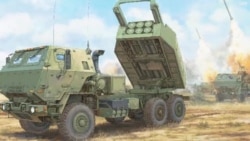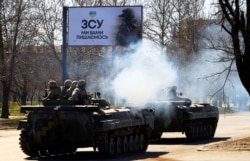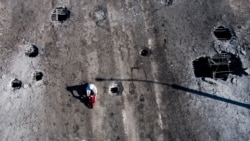On August 1, Ukraine’s defense minister confirmed the country had received four additional M142 High Mobility Artillery Rocket Systems, called HIMARS for short, from the United States.
The same day, the U.S. Department of Defense (DoD) announced more arms and other aid for Ukraine valued up to $550 million, including 75,000 rounds of 155mm artillery ammunition and an unspecified amount of HIMARS ammunition.
Analysts and Ukrainian defense officials have described the HIMARS as a “game changer” in the war because the system allows Ukraine to hit targets from beyond the reach of Russian artillery. HIMARS has been used to blow up Russian ammo dumps and sever supply lines; giving the Kremlin a military and p.r. black eye.
Hence a new line of disinformation from Moscow. Russia claimed in recent weeks to have destroyed six HIMARS, but the Pentagon said that claim is “patently false.”
Russia also claimed, without evidence, that Ukraine used HIMARS to target a Russian-run prisoner, killing 53 Ukrainian prisoners of war. In fact, available evidence and intelligence assessments about the event suggest that Russia was itself behind the explosion, not HIMARS.
Russian state media has also sought to downplay the usefulness of GPS-guided HIMARS, and to dispute their accuracy.
Take this article from Russian state broadcaster RT, headlined “Ukraine is ‘shooting blind’– top official,” which falsely claimed:
“The deliveries of US-made HIMARS rocket systems are 'a good first step’, but the West did not provide Kyiv with the necessary technologies to accurately hit targets, a high-ranking Ukrainian official complained.”
Another article in Russian broadcaster Sputnik was headlined: “Kiev Complains Its US-Gifted HIMARS Rockets are ‘Shooting Blind’.” That false claim is based on an interview that Anton Gerashchenko, a Ukrainian Ministry of Internal Affairs adviser, recently gave to Newsweek.
When asked what additional military assistance Ukraine needed, Gerashchenko replied:
“Presidential adviser Mikhail Podalyak laid out these needs last month: 2,000 troop transport vehicles, 1,000 gun-mounted vehicles, 500 tanks, 300 multiple launch rocket systems, and also the drones and communications equipment necessary to maximize the effectiveness of these systems.
"HIMARS and heavy artillery are a good first step, but if we do not have the technology to find and correct targets for artillery strikes, then we're just shooting blind.”
Gerashchenko pointedly did not say HIMARS are “shooting blind,” but stressed the need for technology to help Ukrainian artillery (not just HIMARS) find targets. His comments also echoed Ukraine’s persistent calls for more military hardware to help defeat Russia.
Polygraph.info reached out to Gerashchenko about his comments but had not heard back from him by the time of publication.
When asked how the United States is helping Ukraine “find and correct targets,” U.S. Defense Department spokesman Lt. Col. Garron Garn told Polygraph.info the United States provides “the Ukrainians with detailed, time-sensitive information to help them understand the threats they face and defend their country against Russian aggression.”
That tracks with comments made by U.S. Under Secretary of Defense for Policy Colin Kahl in June. He said the United States will “provide the Ukrainians what they need to prosecute the targets inside Ukrainian territory.” Ukrainian officials say that includes satellite imagery (more on that below).
As of July 22., U.S. security assistance committed to Ukraine also included 126 155mm howitzers, 700 Phoenix Ghost Tactical Unmanned Aerial Systems, laser-guided rocket systems, Puma Unmanned Aerial Systems, 26 counter-artillery radars, four counter-mortar radars, four air surveillance radars and tactical secure communications systems.
The HIMARS is a light, multiple-rocket launcher mounted on a standard U.S. Army M1140 truck frame.
The HIMARS provided to Ukraine have one preloaded pod of six GPS-guided missiles with a range of up to 50 miles. The system has what the developer, Lockheed Martin, calls a “shoot and scoot capability,” meaning they can be put into position, fire, relocate and reload “in a matter of minutes,” enhancing their survivability. In Ukraine, they are doing anything but shooting blind.
On July 25, Ukraine’s Defense Minister Oleksiy Reznikov said "our gunners use HIMARS very precisely – they work like a surgeon with a scalpel.” Retired U.S. Army General Mark Hertling called that “a strong and accurate comment,” adding that the HIMARS version Ukraine uses has “a 200-lb. warhead, is GPS-guided, and hits what it aims at long range.”
A Ukrainian military spokeswoman described July 26 HIMARS strikes on the Antonovsky bridge, near the Russian-occupied city of Kherson, as “pinpoint.” She added that the damage inflicted from the strike “wasn’t vast enough” to be turned into a Russian propaganda talking point.
Ukraine has targeted other bridges in the region to hinder Russian forces as Ukrainian troops battle to retake Kherson.
On July 25, Ukraine claimed it had destroyed 50 Russian ammunition depots since receiving the HIMARS. Russian command-and-control posts have also been regularly targeted, arguably putting a dent in Russia’s logistics and slowing its forces’ eastern advance.
Overnight on August 2-3, HIMARS were used to strike several Russian bases and arms warehouses in the Kherson region, Newsweek reported, citing local media.
Ukrainian President Volodymyr Zelenskyy said HIMARS had become “synonymous” with the word “justice” for Ukraine. “The Ukrainian defense forces will do everything to ensure that the occupiers experience more and more painful losses every week thanks to these very effective systems,” he said.
Ukraine's deputy military intelligence chief, Vadym Skibitsky, recently told Britain’s Telegraph newspaper that the United States and Britain “have provided almost everything from information to equipment.”
When asked how the U.S. HIMARS have so precisely targeted Russian fuel ammunition depots and battlefield headquarters, Skibitsky replied: “[I]n this case in particular, we use real-time information.”
He said Washington did not provide direct targeting information, which might implicate direct U.S. participation in the war. Still, intelligence officials from both sides consulted before HIMARS strikes, he said, allowing the United States to stop a strike that officials disagree with.
“I can’t tell you whether [we are directly tasking] British and American satellites, but we have very good satellite imagery,” he told The Telegraph.
While Russian media reported HIMARS are firing blind, Moscow also responded to Skibitsky’s interview by accusing the United States of being Ukraine’s “gunner.”
Russia’s Foreign Ministry spokeswoman Maria Zakharova said the real-time information and satellite data Washington provides to Ukraine “points to the direct involvement of the United States of America” in the war.








